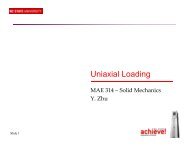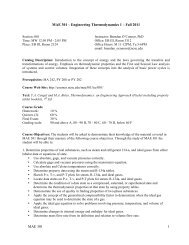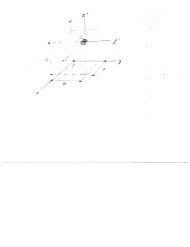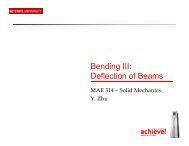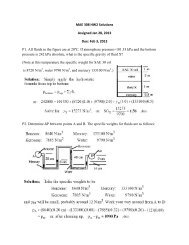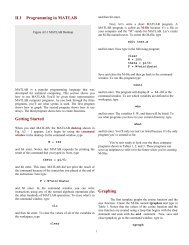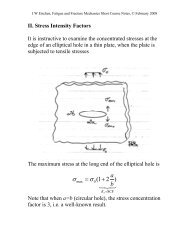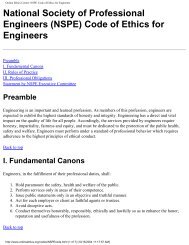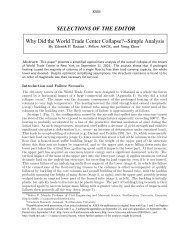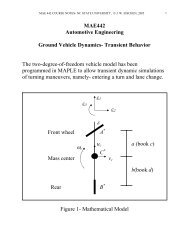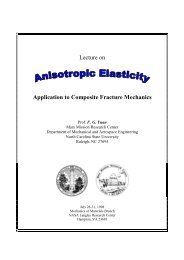Wave reflection and transmission in composite beams containing ...
Wave reflection and transmission in composite beams containing ...
Wave reflection and transmission in composite beams containing ...
Create successful ePaper yourself
Turn your PDF publications into a flip-book with our unique Google optimized e-Paper software.
ARTICLE IN PRESS<br />
W.-C. Yuan et al. / Journal of Sound <strong>and</strong> Vibration 313 (2008) 676–695 681<br />
3.1. Open delam<strong>in</strong>ation<br />
Consider a slender beam conta<strong>in</strong><strong>in</strong>g a semi-<strong>in</strong>f<strong>in</strong>ite delam<strong>in</strong>ation shown <strong>in</strong> Fig. 1(a), the orig<strong>in</strong> of the<br />
coord<strong>in</strong>ate is located at the tip of the delam<strong>in</strong>ation. The beam can be divided <strong>in</strong>to two regions. The left region<br />
is the un-delam<strong>in</strong>ated region which conta<strong>in</strong>s both <strong>in</strong>cident <strong>and</strong> reflected waves; while the right region<br />
encompasses the two delam<strong>in</strong>ated sub-<strong>beams</strong>. S<strong>in</strong>ce the delam<strong>in</strong>ation surfaces are open, there is no contact<br />
pressure between the surfaces. Only positive-go<strong>in</strong>g wave exists <strong>in</strong> the two sub-<strong>beams</strong>, which refers to the<br />
transmitted wave.<br />
Consider<strong>in</strong>g an <strong>in</strong>cident flexural wave travel<strong>in</strong>g <strong>in</strong> the positive x-direction, <strong>in</strong> the left un-delam<strong>in</strong>ated<br />
region (xp0) when the excitation frequency is greater than the cut-off frequency, the wave fields consist<br />
of two positive-go<strong>in</strong>g <strong>in</strong>cident flexural waves <strong>and</strong> two negative-go<strong>in</strong>g reflected flexural waves that can be<br />
written as<br />
w 0 ¼ a e ik1x þ b e ik2x þ a r e ik1x þ b r e ik2x ,<br />
(20a)<br />
c 0 ¼ F 1 a e ik1x þ F 2 b e ik 2x<br />
F 1 a r e ik 1x<br />
F 2 b r e ik2x .<br />
(20b)<br />
Due to the moment cont<strong>in</strong>uity on the junction, an <strong>in</strong>duced extensional wave may also be reflected from the<br />
discont<strong>in</strong>uity <strong>and</strong> transmitted <strong>in</strong>to two sub-<strong>beams</strong>. The negative-go<strong>in</strong>g reflected extensional wave <strong>in</strong> the left<br />
region can be expressed as<br />
u 0 ¼ c r e ikex ,<br />
(20c)<br />
where the time dependence term e iot has been suppressed here <strong>and</strong> hereafter. When the excitation frequency<br />
is below the cut-off frequency, i.e., ooo c , the second pair wave mode becomes evanescent s<strong>in</strong>ce the<br />
wavenumber k 2 is purely imag<strong>in</strong>ary. The choice of the sign <strong>in</strong> k 2 is dictated by the condition that the reflected<br />
wave field is f<strong>in</strong>ite as x- N. In this case, the sign of k 2 is deliberately chosen to be negative. The coefficients<br />
of a <strong>and</strong> b represents the amplitude of <strong>in</strong>cident wave depend<strong>in</strong>g on the details of the load<strong>in</strong>g away from the<br />
discont<strong>in</strong>uity. When excited at far field <strong>in</strong> the low frequency b can be set to zero. In the limit when frequency<br />
approaches <strong>in</strong>f<strong>in</strong>ity, the group velocities of the two modes are given by Eq. (17).<br />
In the right delam<strong>in</strong>ated region (xX0) where the crack surfaces are completely open, the displacements<br />
of the two <strong>in</strong>dependent sub-<strong>beams</strong> are denoted by u 1 , w 1 , c 1 , u 2 , w 2 , c 2 . The subscripts 1 <strong>and</strong> 2<br />
denote the upper <strong>and</strong> lower sub-<strong>beams</strong>, respectively. S<strong>in</strong>ce waves are transmitted from the <strong>in</strong>cident waves<br />
through the discont<strong>in</strong>uity, the general solutions of displacement for the transmitted waves <strong>in</strong> each sub-beam<br />
are given by<br />
c n ¼ F ðnÞ<br />
w n ¼ a ðnÞ<br />
t e ikðnÞ<br />
1 aðnÞ t<br />
e ikðnÞ 1 x þ F ðnÞ<br />
1 x þ b ðnÞ<br />
2 bðnÞ t<br />
t<br />
e ikðnÞ 2 x , (21a)<br />
e ikðnÞ 2 x ðn ¼ 1; 2Þ, (21b)<br />
u n ¼ c ðnÞ<br />
t e ikðnÞ e x , (21c)<br />
(n)<br />
where superscripts (1) <strong>and</strong> (2) denote the parameters associated with each sub-beam. The wavenumber k j<br />
<strong>and</strong> F (n) j can be readily obta<strong>in</strong>ed by substitut<strong>in</strong>g the stiffness <strong>and</strong> moment of <strong>in</strong>ertia perta<strong>in</strong><strong>in</strong>g to the each subbeam<br />
<strong>in</strong> Eqs. (4), (5) <strong>and</strong> (9). Accord<strong>in</strong>g to Eq. (19), the wavenumber of the extensional wave is <strong>in</strong>dependent of<br />
beam thickness imply<strong>in</strong>g k e ¼ k (1) e ¼ k (2) e .<br />
The cut-off frequency of each sub-beam can be written as follows:<br />
qffiffiffiffiffiffiffiffiffiffiffiffiffiffiffi<br />
o ð1Þ<br />
c ¼ kc s =q ð1Þ ; o ð2Þ<br />
c ¼ kc s =q ð2Þ , (22)<br />
where q ðnÞ ¼ (n ¼ 1,2).<br />
The group velocities of two flexural wave modes <strong>in</strong> each sub-beam at <strong>in</strong>f<strong>in</strong>ite frequency, accord<strong>in</strong>g to<br />
Eq. (17), are<br />
I ðnÞ ðnÞ<br />
2<br />
=I<br />
1<br />
c ðnÞd<br />
g0<br />
¼ kc s ; c ðnÞd<br />
g1<br />
¼ c l as o !1 ðn ¼ 1; 2Þ, (23)<br />
where the superscript d denotes the delam<strong>in</strong>ated <strong>beams</strong>.




